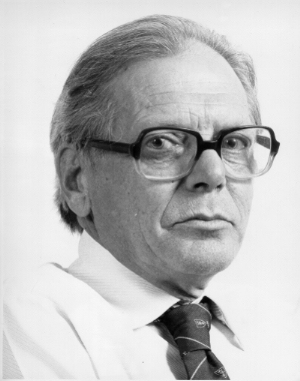 Tom Kaiser, one of the leading figures in UK MIST science from the 1950s to the 1970s, died on 2 July 1998. Tom was born and brought up in Melbourne, Australia, but came to England in 1947 and gained his PhD at Oxford for his thesis on the acceleration of charged particles in synchrotron orbits. He then moved to Jodrell Bank where his experimental and theoretical studies of radar reflections from meteor trails became the definitive work on the subject.
Tom Kaiser, one of the leading figures in UK MIST science from the 1950s to the 1970s, died on 2 July 1998. Tom was born and brought up in Melbourne, Australia, but came to England in 1947 and gained his PhD at Oxford for his thesis on the acceleration of charged particles in synchrotron orbits. He then moved to Jodrell Bank where his experimental and theoretical studies of radar reflections from meteor trails became the definitive work on the subject.
Tom moved to Sheffield University in 1956, a year before the launch of Sputnik-1 and the dawn of the space age, and founded the Space Physics group; he was later appointed Professor of Space Physics. Initially the work focused on ionospheric sounding experiments carried aboard Skylark and Petrel rockets, but Tom soon became involved in Ariel-3, the first entirely British scientific satellite, launched in 1967, which carried a range of instruments to measure particles, fields and waves in the topside F-region. The Sheffield contribution was a sophisticated (for the time) survey instrument for VLF wave emissions, the design of which involved pioneering engineering to overcome interference problems on the satellite. The data from this experiment and its successor on Ariel-4 launched in 1971 were exploited by the Sheffield group and collaborators to provide a wealth of new knowledge in this field.
In support of the Ariel-3 and Ariel-4 programmes, Tom worked with the British Antarctic Survey to establish compatible VLF receivers on the ground, at Halley Bay, Antarctica. His visit there in 1972, accompanied by Roy Piggott, formed the basis for many subsequently recounted anecdotes. Although the original purpose of the Antarctic observations was to provide "ground truth" for the Ariel satellite receivers, they have continued to the present day a tribute to Tom's foresight, and now provide a valuable long-term database for understanding magnetospheric and ionospheric wave generation and propagation.
Tom was respected for his scientific intellect as well as his human qualities as a colleague and teacher; he made a significant contributions in several MIST fields, particularly radar studies of the aurora, and whistler mode waves in the magnetosphere and ionosphere. He had a broad approach and could turn his hand and his mind equally to the innards of a radar transmitter or the arcane mathematics of theoretical plasma physics. He was a keen lacrosse player in his spare time. In any non-scientific debate with him it quickly became apparent that his political views were decidedly left-wing; he had been associated with the Communist Party and for much of his career was banned from entering the United States. He retired in 1987 and unfortunately suffered ill-health in later years, but recently his achievements were deservedly recognised by the award of the prestigious Gold Medal of the Royal Astronomical Society. He is survived by his wife Pam, two sons (who followed him into science) and a daughter.
AJS, July 1998